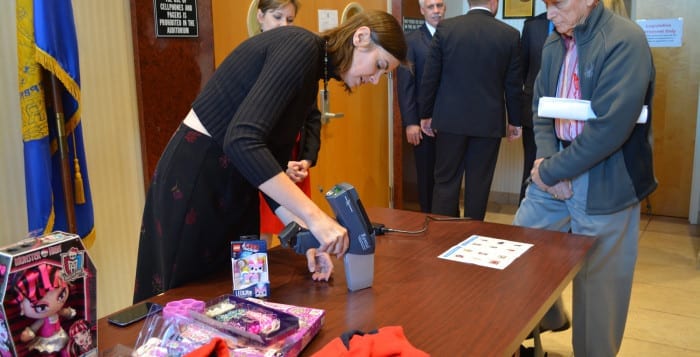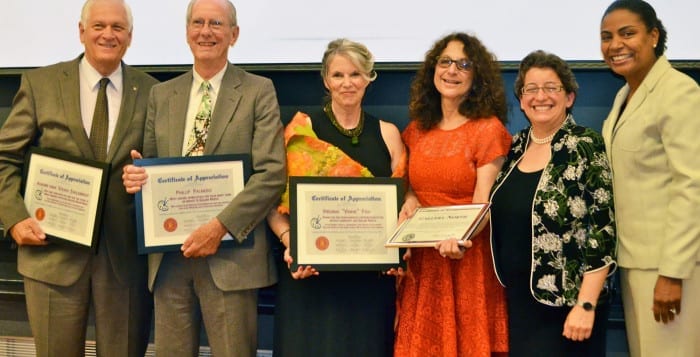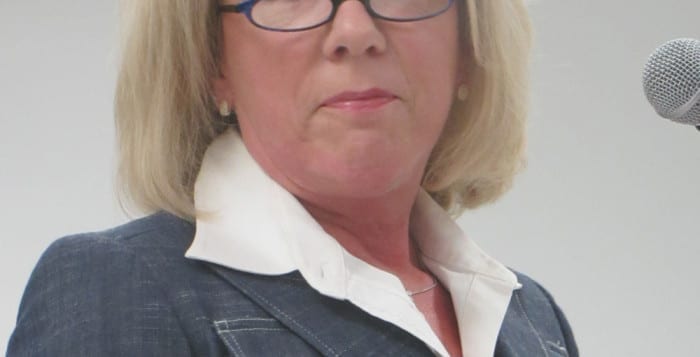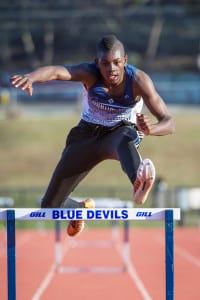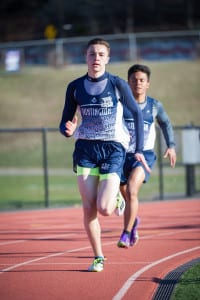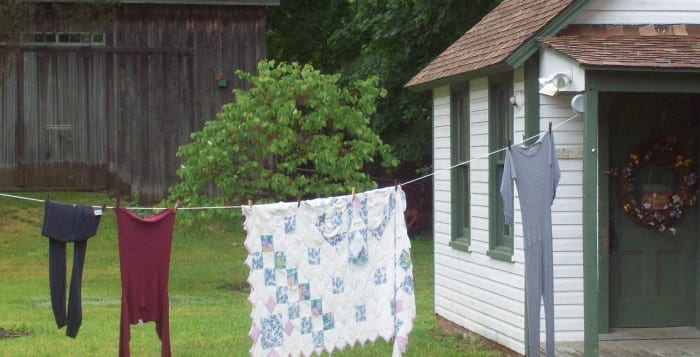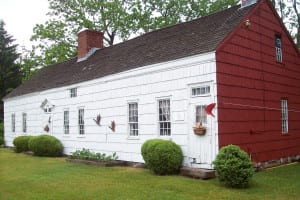By Sue Wahlert
Gallery North’s “50 & Forward” Gala was held last Friday at The Simons Center for Geometry and Physics on the campus of Stony Brook University. It was an opportunity to “honor the past and look to the future,” said Gallery North Director Judith Levy. Honoree Assemblyman Steve Englebright (D-Setauket) reflected, “Gallery North anchors part of our history and heritage,” speaking of the 1875 boarding house which is the current Gallery North. He continued by saying that this celebration is, “an important milestone for the North Country Road Historic community.”
Guests entered the sunlit atrium while pianist Conal Fowkes, Woody Allen’s collaborator at the Café Carlyle, set the tone for a lovely evening of socializing, fundraising and honoring those vital to the past, present and future of Gallery North.
Silent auction items lined the edges of the room, some of which were donated paintings by artists Bruce Lieberman, Nancy Bueti-Randall, Terence Netter, elegant necklaces by Pearl Ehrlich and Jan LaRoche; and many more fine choices. A delicious buffet prepared by Chef Paolo Fontana and his staff of the SCGP Café was served on the second floor where guests also enjoyed the patio and outdoor gardens.
The celebration comes at an exciting time for Gallery North, as they are in the final stages of completing the Community Art Center, which will enable the Gallery to better serve the community’s art needs. “We are really excited about the Community Art Center,” said Nancy Goroff, president of Gallery North. The state-of -the-art, handicapped-accessible building will house a collaborative printmaking studio for artists and students, offer a mentoring program and allow for the expansion of the existing programs such as Studio Art Workshops, ArtVentures for Kids, ArTalks, ArtWorks and ArtAbilities.
The evening was an opportunity for artists, patrons of the arts and community members to join together for a celebration. Levy reflected on the evening, “Members of the community were there to support us and help us raise money. As a non-profit institution, that is very important to our survival.” A highlight of the evening for Levy was, “listening to the honorees speak about what Gallery North has meant to them as members of the community, art lovers, and appreciators, as well as public officials.”
Following dinner, guests gathered for the honoree ceremony and live auction. The evening’s honorees: Englebright, Virginia “Vinnie” Fish and Philip Palmedo, were introduced by Gallery North’s Secretary/Treasurer Doug Dahlgard.
Englebright was acknowledged by Dahlgard for having “an unwavering commitment to the growth of not-for-profits and honored him for his wholehearted support.” Englebright spoke of the value the Gallery brings to the community and was proud to announce that he secured a $60,000 challenge grant from New York State, which would be used toward keeping Gallery North strong and vital for many years to come. Gallery North must now raise $60,000 within one year, to match the State grant of the same amount. Englebright reflected on the new Community Art Center, saying that it, “will embrace our children.”
The second honoree, Palmedo, was a Gallery North trustee from 1978 to 2008 and is a Trustee Emeritus. Palmedo spoke of how he and his wife moved from Paris to Long Island many years ago and were delighted that they had found a gallery that was showing contemporary art. His belief is that, “art is indeed important” and that the Gallery is, “as vigorous as it was 50 years ago.” His gratitude is shown through his continuous support of Gallery North.
Although the final honoree, artist and Trustee Emeritus Virginia “Vinnie” Fish, was unable to attend the ceremony, she sent along a short film talking about the early beginnings of the Gallery and the role her mother, Virginia Fuller, one of the gallery’s founders, played in “giving to others and making life better for others.”
She reflected that, “before Gallery North there were only horse shows” and that “it changed the community.”
Fish worked as Gallery North’s president from 1989 to 1997. She created its 30th anniversary show, which “generated acclaim and attention from the greater art world.” During her term as president, the Gallery received it’s full 501(c)(3) tax status.
Councilwoman Valerie Cartright (D-Port Jefferson Station) was on hand to present certificates of appreciation to each of the honorees, as well as one to Gallery North, proclaiming “We are honored to have Gallery North in our community.”
Following the ceremony, a lively auction took place, where generous bids were made for a trip to an Austrian chalet, a weeklong vacation in Deer Valley, Utah, and a weekend stay in a Manhattan apartment. The bidding continued, as people donated money to match an anonymous donation of $15,000. Certified Christie’s Auctioneer, Alison Delaney, successfully guided the audience in a lighthearted but important part of the evening.
The Gallery is well on their way to matching the $60,000 challenge grant.
Goroff said of the evening, “It was wonderful to see how many people stepped up at the Gala to help meet the challenge. We still have more to raise, but with such a strong start, we are confident we can do it!”
The event, which wound down with music, dancing, drinks and dessert, marked the beginning of the next 50 years with shows to be curated, a Community Art Center to open and the ongoing support of artists, art lovers and community members.
Gallery North is located at 90 North Country Road in Setauket. If you would like to join the gallery in reaching its potential and beyond, please log onto their website at www.gallerynorth.org or call 631-751-2676.




